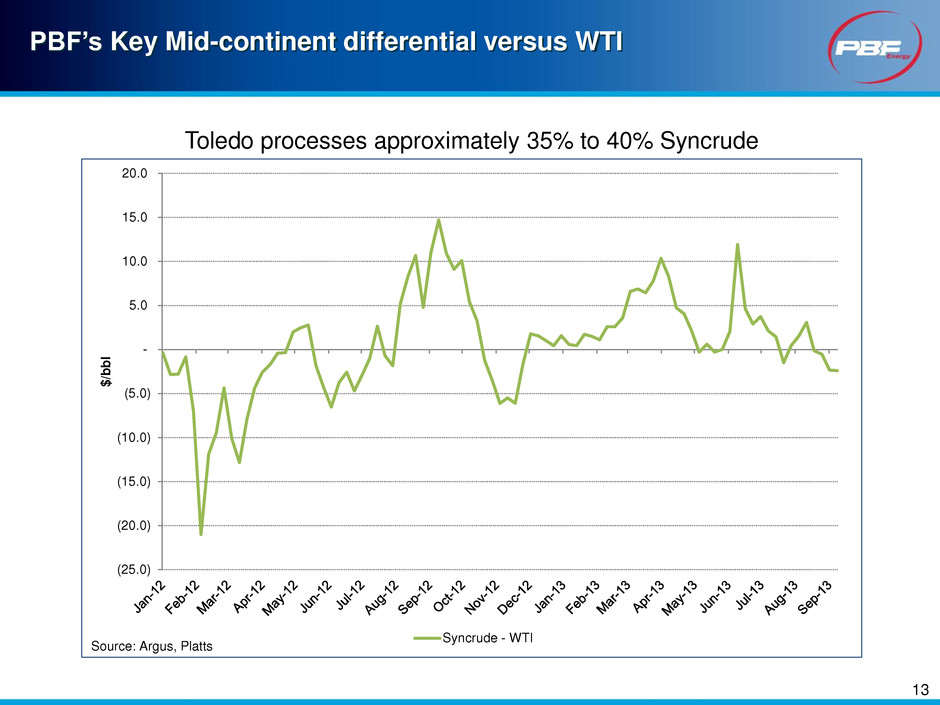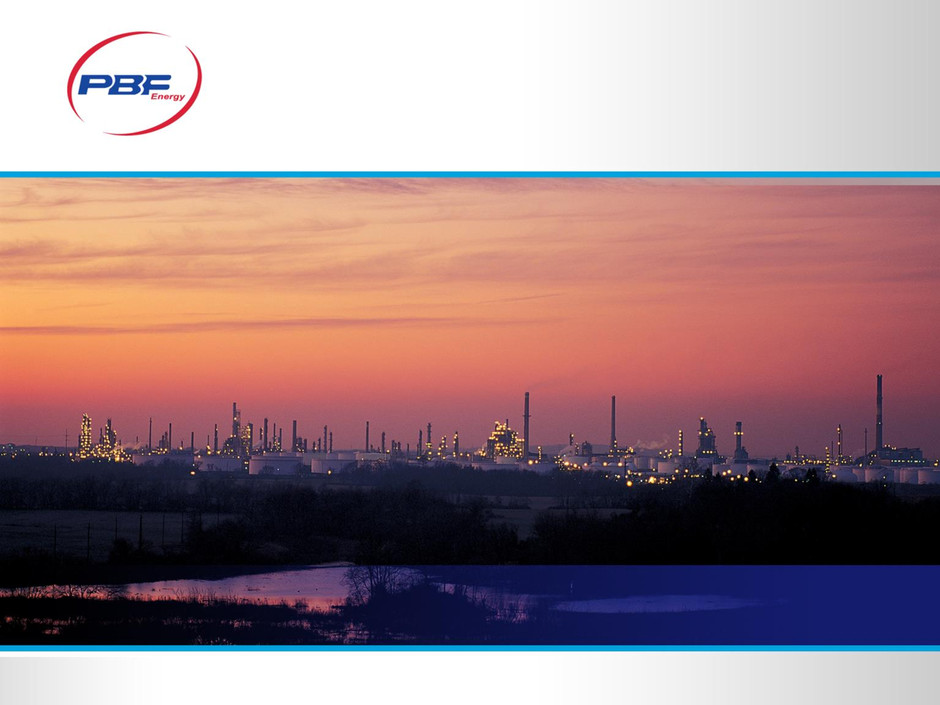Attached files
| file | filename |
|---|---|
| 8-K - 8-K - PBF Energy Inc. | a9-12x138xk.htm |

PBF Energy Inc. Barclays CEO Energy-Power Conference September 12, 2013

2 Legal Notice / Forward-Looking Statements This presentation contains forward-looking statements made by PBF Energy Inc. (the “Company” or “PBF”) and its management. Such statements are based on current expectations, forecasts and projections, including, but not limited to, anticipated financial and operating results, plans, objectives, expectations and intentions that are not historical in nature. Forward-looking statements should not be read as a guarantee of future performance or results, and may not necessarily be accurate indications of the times at, or by which, such performance or results will be achieved. Forward-looking statements are based on information available at the time, and are subject to various risks and uncertainties that could cause the Company’s actual performance or results to differ materially from those expressed in such statements. Factors that could impact such differences include, but are not limited to, changes in general economic conditions; volatility of crude oil and other feedstock prices; fluctuations in the prices of refined products; actions taken or non-performance by third parties, including suppliers, contractors, operators, transporters and customers; adequacy, availability and cost of capital; work stoppages or other labor interruptions; operating hazards, natural disasters, weather-related delays, casualty losses and other matters beyond our control; inability to complete capital expenditures, or construction projects that exceed anticipated or budgeted amounts; inability to successfully integrate acquired refineries or other acquired businesses or operations; effects of existing and future laws and governmental regulations, including environmental, health and safety regulations; effects of litigation; and, various other factors. Forward-looking statements reflect information, facts and circumstances only as of the date they are made. The Company assumes no responsibility or obligation to update forward-looking statements to reflect actual results, changes in assumptions or changes in other factors affecting forward-looking information after such date.

3 U.S. Refining Industry Strengths Inexpensive Natural Gas Growth in supply driving decline in U.S. natural gas pricing ― U.S. natural gas currently priced more than 60% below Europe ― ~$0.10 / bbl benefit to domestic refiners for every $1 / MMBtu difference in natural gas price North American Crude Oil Production Secular growth in North American crude oil production ― Favorable price dislocations between North American crude and rest of world Complex Refineries U.S. average refinery Nelson Complexity of 10.9 versus Western European average refinery Nelson Complexity of 7.8 Product Exports Cost and technological advantages have spurred export opportunities ― East Coast to Europe, West Africa, and Latin America Why will the U.S. refining industry prosper for the next 5 years?

4 PBF owns three oil refineries located in Ohio, Delaware and New Jersey ― Aggregate throughput capacity of approximately 540,000 barrels per day ― Weighted-average Nelson Complexity of 11.3 ― Fifth largest U.S. independent refiner ― East Coast rail infrastructure provides the entire system access to WTI-based, cost-advantaged crude supply Summary Company Profile Cushing Toledo Paulsboro Delaware City Region Throughput Capacity (bpd) Date Acquired Nelson Complexity Replacement Cost Benchmark Crack Spread Mid-Continent 170,000 3/1/2011 9.2 $2.4 billion WTI (Chicago) 4-3-1 East Coast 370,000 2010 12.2 $5.8 billion Dated Brent (NYH) 2-1-1 Total 540,000 11.3 (1) $8.2 billion (1) Represents weighted average Nelson Complexity for PBF’s three refineries

5 Toledo Refinery Optimization Project Expected Completion Capital, MM$* Benefit, MM$/yr EBITDA* Crude Unloading by Truck Complete 4.5 11.0 Buckeye Pipeline Products Outlet Complete 4.9 Additional Crude Tank Q3-2014 18.3 16.0 Chemicals Expansion Q4-2014 20.0 19.0 FCC Strategic Projects 32.0 Reactor Stripper Upgrade Q4-2014 5.0 Reactor Termination Device Q4-2014 25.0 Reactor Shell Replacement Q4-2014 8.0 Estimated Total Costs and Benefit $85.7 $78.0 * Estimates are based on current assumptions and plans and are subject to change. EBITDA (Earnings before Interest, Income Tax, Depreciation and Amortization) is a non-GAAP financial measure. PBF believes that this non-GAAP financial measure provides useful information about its expectations for the future performance and financial results of its Toledo Optimization Projects, but should not be considered superior to a GAAP financial measure.

6 Increasing access to cost-advantaged North American crude production PBF’s onsite rail infrastructure at Delaware City provides the opportunity to save approximately $3/bbl on delivered Bakken barrels versus using 3rd party facilities

North American Crude Production U.S. crude production is estimated to grow by 35% in 2013 from 2010 ― Pushes barrels South (via water, pipeline and rail), East and West (primarily by rail) ― Ultimately displaces USGC imports Canadian crude production is expected to grow by 25% in 2013 from 2010 ― Bitumen by rail advantaged versus pipeline transportation of diluted crudes MMB/D Source: PIRA, EIA & CAPP 7 2.8 3.5 3.9 4.9 5.5 7.4 8.0 10.7 8.3 10.9 11.9 15.6 0.0 2.0 4.0 6.0 8.0 10.0 12.0 14.0 16.0 18.0 2010 2013 2015 2020 Canada U.S.

Unit Trains Arriving at Double-Loop Track The dual-loop track light crude unloading facility is capable of discharging a unit train (~70,000 bbl) in ~14 hours, a capacity of approx.120,000 bpd 8 Bakken Deliveries (Actual/Estimate) (bpd) 2013 1st Quarter 38,000 2013 2nd Quarter 75,000 2013 3rd Quarter 70,000 – 75,000* 2013 4th Quarter 85,000 – 90,000* * Estimates are based on current assumptions and plans and are subject to change. PBF is able to deliver Bakken barrels to Delaware City at a cost of approximately $12 per barrel

Transportation costs decline from above $20 per barrel to below $17 per barrel as PBF-controlled railcar fleet expands PBF Rail Deliveries of Canadian Heavy Crude Deliveries of Canadian heavy crude are dependent on access to coiled and insulated railcars as well as rail transloading facilities in Canada 9 Expected Canadian Heavy Deliveries (bpd)* 2013 3rd Quarter 30,000 – 35,000 2013 4th Quarter 20,000 – 25,000** 2014 1st Quarter 35,000 – 40,000 2014 2nd Quarter 35,000 – 40,000 2014 3rd Quarter 70,000 – 80,000 2014 4th Quarter 70,000 – 80,000 * Estimates are based on current assumptions and plans and are subject to change and project completion timelines ** The Q4-13 turnaround at Delaware City will reduce the amount of Canadian heavy crude oil processed at the refinery in Q4-13

10 Crude-by-Rail Pipeline Planned Leased or Owned Railcars Note: Schedule is subject to change based on company plans and on current third party railcar manufacturer delivery schedules Longer-term focus on logistics ― Rail services agreements with Norfolk Southern and BNSF Increased ability to load unit trains ― Transloading agreement with Savage in Trenton, ND Advantageous commercial arrangements with crude producers ― Supply agreement with Continental Resources for Bakken Ensuring delivery ― Agreement with Trinity for delivery of rail cars ― Increased availability of “delivered” deals - 1,000 2,000 3,000 4,000 5,000 6,000 2Q13 3Q13 4Q13 1Q14 2Q14 3Q14 4Q14 1Q15 2Q15 3Q15 4Q15 Coiled & Insulated General Purpose

11 PBF MLP Submitted confidential registration statement in August 2013 PBF has identified a pool of assets that could be contributed to a logistics-focused Master Limited Partnership (MLP) Possible MLP assets include but are not limited to: ― Rail terminals and railcars ― Refinery truck terminals ― Pipeline assets ― Tank storage facilities

No near-term debt maturities ― $675.5 million 8.25% Senior Secured Notes due 2020 Net Debt/Net Cap was approximately 30% as of June 30, 2013 Liquidity ― $1.575 billion Asset-Backed Facility (with accordion up to $1.8 billion) ― Approximately $650 million of liquidity as of June 30, 2013 12 PBF’s Strong Financial Position PBF Financial Snapshot – June 30, 2013 ($MM, Unless Otherwise Noted) Capitalization Table Actual Cash and Cash Equivalents $69.2 Debt Long-Term Debt (excluding revolver) 721.0 Total Debt 816.0 Net Debt 746.8 Total Equity 1,741.9 Net Capitalization 2,488.7

13 PBF’s Key Mid-continent differential versus WTI Toledo processes approximately 35% to 40% Syncrude (25.0) (20.0) (15.0) (10.0) (5.0) - 5.0 10.0 15.0 20.0 $/b b l Syncrude - WTI Source: Argus, Platts

14 Brent versus WTI Narrowing Brent – WTI differential negatively impacts cost-advantage of North American produced crude oils (30.0) (25.0) (20.0) (15.0) (10.0) (5.0) - $/b b l WTI - Brent Source: Argus, Platts

15 PBF Crude-by-Rail Differentials versus Brent Narrowing differentials impact rail economics for North American produced crude oil processed at PBF’s East Coast refineries (70.0) (60.0) (50.0) (40.0) (30.0) (20.0) (10.0) - $/b b l WCS - Brent Bakken - Brent Source: Argus, Platts

16 ASCI Differential versus Brent ASCI is an indicator for medium-sour barrels processed at PBF’s East Coast facilities (12.0) (10.0) (8.0) (6.0) (4.0) (2.0) - 2.0 $/b b l ASCI - Brent Source: Argus, Platts

PBF’s East Coast Benchmark Crack 17 NYH 2:1:1 = (–2)*(Dated Brent) + 1*(NY RBOB) + 1*(NO.2 Heating Oil) - 5 10 15 20 25 30 $/b b l 2:1:1 Source: Platts

PBF’s Mid-continent Benchmark Crack Chicago 4:3:1 = (–4)*(WTI) + 3*(Chic CBOB pipe) + .5*(Chic ULSD Pipe) + .5*(USGC Jet Kero 54) 18 - 5 10 15 20 25 30 35 40 45 50 $/b b l 4:3:1 Source: Platts

19 What will the future bring? Fundamentals have not changed ― North American refiners have a cost advantage with access to cheap natural gas ― North American crude oil production continues to increase ― US crude export ban remains in place ― US refiners can export products PBF’s assets are well positioned to take advantage of these market conditions

